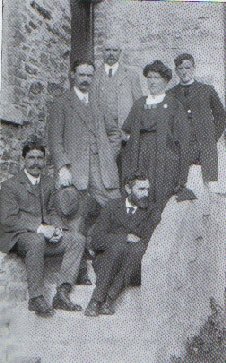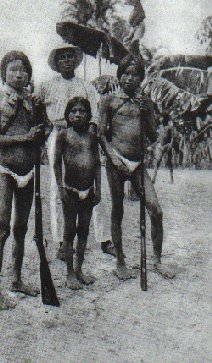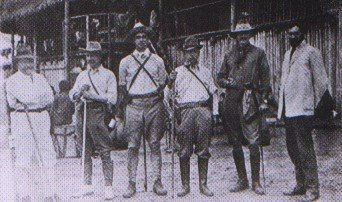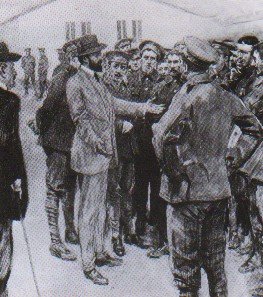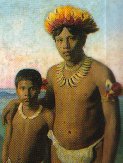| Because of
Casement's reputation as a humanitarian, even in England
at a time of war there were many people who asked for the
death penalty to be commuted when Casement was sentenced
to death for high treason. Among these people were Sir
Arthur Conan Doyle, Arnold Bennett, G K Chesterton, Sir
James G Fraser, John Masefield, Beatrice and Sidney Webb,
C P Scott (editor of the Manchester Guardian),
the Rev Thomas Phillips (President of the Baptist Union),
and the Bishop of Winchester. To quell these, and other
appeals for clemancy, the government mounted a propaganda
campaign, using extracts from the 'Black Diaries' which
they attributed to Casement and which described
homosexual adventures and acts. The controversy about the
authorship of the 'Black Diaries' continues, and some
believe they were forged to destroy Casement's
reputation. However that may be, it is fairly clear that
Casement was homosexual in his sexual orientation. |
I saw that
Roger Casement
Did what he had to do.
He died upon the gallows,
But that is nothing new.
Afraid they
might be beaten
Before the bench of Time,
They turned a trick by forgery
And blackened his good name.
A perjurer
stood ready
To prove their forgery true;
They gave it out to all the world,
And that is something new.
Come Tom and
Dick, come all the troop
That cried it far and wide,
Come from the forger and his desk,
Desert the perjurer's side:
Come speak
your bit in public
That some amends be made
To this most gallant gentleman
That is in quicklime laid.
- W B Yeats
|
Mar gheall
ar an clú a bhí ar Mac Easmainn mar gheall ar an obair
a bhí déanta aige sa Chongó agus sa Phutumayo, bhí
alán daoine (fiú i Sasana agus fiú agus an cogadh faoi
lán seoil) a d'iarr ar an rialtas breith an bháis a
chur ar cheal nuair a dhaoradh chun báis é as an tréas
a chuireadh ina a leith: i mease na ndaoine seo bhí An
Ridire Arthur Conan Doyle, Arnold Bennett, G K
Chesterton, An Ridire James G Fraser, John Masefield,
Beatrice & Sidney Webb, C P Scott (eagarthóir an Manchester
Guardian), An t-Urramhach Thomas Phillips
(Uachtarán an Baptist Union) agus Easbog Winchester.
Chun na héilimh seo agus éilimh eile a chur ar neamhní
chuir an rialtas feachtas bolscoireachta ar siúl. Bhain
siad úsáid as 'Dialanna Dubha' a chuir siad i leith
Mhic Easmainn ina raibh cur síos ar eachtraí
homaighnéasacha. Maireann conspóid i gcónaí agus
ceapann roinnt gur ceapadh iad mar chuid d'fheachtas an
rialtais chun clú Mhic Easmainn a scriosadh. Ach pé
fíor bréagach é sin, tá cuma ar an scéal gur fear
aerach a bhí ann. |




